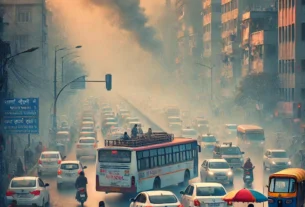On March 27, 2024, India celebrated a monumental achievement in public health: a decade of being polio-free. This milestone marks a remarkable journey from a time when India was the epicentre of the global polio epidemic, reporting the highest number of cases worldwide. The journey to eradication was fraught with challenges, including the nation’s vast and diverse population, geographical barriers, and the highly infectious nature of the poliovirus.
The turning point came with the launch of the Pulse Polio Immunisation Program, an ambitious initiative that saw millions of health workers and volunteers mobilise to vaccinate children across the country. This Herculean effort involved door-to-door campaigns, innovative strategies like the polio vaccine booths at railway stations, and relentless public awareness drives to dispel myths and encourage participation.
The success of India’s polio eradication campaign is a testament to the power of collective action, robust public health strategies, and unwavering commitment. It serves as an inspiring model for other nations striving to eliminate polio and a reminder of the possibility of triumphing over seemingly insurmountable odds. As India marks a decade of being polio-free, it stands as a beacon of hope in the global fight against infectious diseases.
Also read: Sonam Wangchuk ends 21-day fast
What were the challenges?
India’s journey to eradicating polio was fraught with numerous challenges that tested the resilience and determination of its healthcare system. One of the most significant hurdles was the sheer size of the population, with millions of children needing vaccination in remote and inaccessible areas. The logistical nightmare of reaching every child, coupled with the need for multiple rounds of immunisation, required meticulous planning and coordination.
Furthermore, public scepticism and resistance posed a major obstacle. Misinformation and cultural beliefs led many communities to refuse vaccination, fearing adverse effects or questioning the vaccine’s halal status. Overcoming this hesitancy demanded innovative communication strategies, including involving religious leaders and local influencers to endorse the campaign.
Another challenge was the high population density and poor sanitation in urban slums, which provided a breeding ground for the poliovirus. Ensuring vaccine efficacy in such environments required a robust cold chain system and relentless monitoring.
The polio eradication effort also had to contend with political instability and regional conflicts, which hampered access to certain areas. Health workers faced threats and violence, making the delivery of vaccines a perilous task in some regions.
Despite these obstacles, India’s unwavering commitment and adaptability led to the successful eradication of polio. The lessons learned from this triumph continue to inform public health strategies, not only in India but around the world.
Pulse Polio Immunisation Program Strategy
India’s strategy to combat polio was a masterclass in public health orchestration. Picture this: a nation mobilising over 23 lakh foot soldiers, not for war, but for a war against polio. These volunteers, armed with vaccine vials, embarked on a door-to-door mission to ensure no child was left behind. The Pulse Polio Immunisation Program was a well-oiled machine, coordinating mass vaccination drives that covered the length and breadth of the country, from the bustling cities to the remotest villages.
But the battle didn’t end there. India’s approach was multifaceted, with innovative tactics like setting up polio booths at railway stations to catch those slipping through the cracks. The campaign’s secret sauce? A relentless public awareness drive, debunking myths and winning hearts, one vaccine at a time. This colossal effort was backed by a symphony of global and local organisations, all playing their part to the tune of a polio-free India. The result? A public health victory that resonated around the world, proving that when India sets its mind to something, there’s no stopping it.
India’s Polio Battle: The Strategy Behind the Success
When India rolled up its sleeves to tackle polio, it wasn’t just a jab in the arm – it was a colossal, well-oiled machine in action. Millions of volunteers, a sea of determined faces, each on a mission to immunise 170 million tiny tots. It was a numbers game, and India was playing to win.
This is where the Pulse Polio Immunisation Program, the heartbeat of the campaign worked like a well-oiled machine, unleashing two nationwide vaccination rounds each year, aiming to outsmart the pesky poliovirus.
But it wasn’t just about the numbers. It was about reaching every nook and cranny, from bustling cities to remote hamlets. Vaccination booths popped up everywhere – schools, public spaces, and even railway stations, because why not catch ’em on the move?
And then there were the special ops: mobile teams trekking through jungles, sailing across rivers, and yes, even riding elephants to ensure no child was left behind.
But what’s a campaign without a bit of star power? Actors and celebrities from all walks of life stepped into the limelight, urging parents to join the fight against polio. Community leaders and local heroes became the voice of reason, dispelling myths and rallying the troops.
Behind the scenes, it was a tale of collaboration. The Indian government, with its ironclad commitment, joined forces with global giants like WHO, Rotary International, and UNICEF. Together, they formed an unstoppable alliance, armed with technical know-how, logistical prowess, and a shared vision.
Also read: Is DMK empowering Tamil Nadu?
Impact and Results: A Nation Transformed
- Dramatic Reduction in Polio Cases: Before the program’s launch, India bore the global burden of polio, with over 200,000 cases reported annually. The relentless vaccination drives led to a staggering decline in cases. Within a decade, the country reported its last wild poliovirus case in 2011.
- Polio-Free Status Achieved: On March 27, 2024, India officially celebrated 10 years of being polio-free. This remarkable achievement signifies the elimination of the indigenous virus, a monumental public health victory.
- Saved Lives and Improved Quality of Life: By eradicating polio, India has prevented countless children from suffering the devastating consequences of the disease. This translates to a healthier population, reduced strain on healthcare systems, and improved overall well-being for millions.
Challenges and Solutions: Overcoming Obstacles
The road to polio eradication was not without its hurdles. Here are some key challenges and the solutions implemented:
- Vaccine Hesitancy: Misinformation and distrust in the vaccine were significant hurdles.
The program tackled this by:
- Community Engagement: Local health workers engaged in door-to-door campaigns, dispelling myths and addressing concerns directly with families.
- Religious Leaders as Advocates: Religious leaders were enlisted to promote vaccination within their communities, fostering trust and encouraging participation.
- Transparency and Communication: Clear communication strategies were implemented to educate the public about the safety and efficacy of the polio vaccine.
- Reaching Remote Areas: Logistical difficulties in geographically isolated regions posed a challenge.
The campaign addressed this through:
- Mobile Vaccination Teams: Dedicated teams travelled by foot, boat, and even on elephants to reach remote communities.
- Collaboration with Local Communities: Local knowledge and expertise were leveraged to identify the best way to reach children in these areas.
- Maintaining Momentum: Sustaining vaccination coverage over a long period was crucial.
The program ensured this by:
- Focus on Sustainability: The program was designed for long-term impact, with a focus on building capacity within the healthcare system.
- Regular Monitoring and Evaluation: Regular data analysis and feedback loops were established to identify areas requiring additional focus and ensure continuous improvement.
Lessons Learned: A Blueprint for Success
- The success of India’s polio eradication program offers valuable lessons for future public health initiatives:
- Importance of Mass Vaccination: Large-scale vaccination drives are crucial for achieving herd immunity and interrupting disease transmission.
- Community Mobilisation and Engagement: Building trust and addressing concerns within communities are vital for successful public health interventions.
- Collaboration is Key: Strong partnerships between government, international organisations, and local communities are essential for long-term success.
- Data-driven Decision Making: Regular monitoring and data analysis allow for continuous improvement and adaptation of strategies.
Future Implications: Maintaining a Polio-Free India
While India has achieved polio-free status, vigilance remains crucial. Here’s why:
- Risk of Importation: The poliovirus remains endemic in a few countries. Continued travel and trade create a risk of the virus being reintroduced.
- Maintaining Herd Immunity: High vaccination coverage must be maintained to prevent outbreaks.
- Surveillance Systems: Robust surveillance systems are vital to detect any potential cases of poliovirus and prevent its spread.
India’s future efforts will likely focus on:
- Sustained Vaccination Programs: Routine immunisation drives for polio will continue to be a priority to ensure high levels of population immunity.
- Global Efforts: India remains committed to collaborating with the international community to eradicate polio globally.
- Strengthening Surveillance: Enhanced surveillance systems will constantly monitor for any potential resurgence of the virus.
India’s journey to polio eradication is a story of perseverance, dedication, and collaboration. By sharing its lessons learned and continuing its commitment to vaccination and surveillance, India can inspire other nations and contribute to a world free from this crippling disease.
Also read: Electoral bonds unmasked




